The human brain has 100 billion neurons, making 100 trillion connections. Understanding the precise circuits of brain cells that orchestrate all of our day-to-day behaviors—such as moving our limbs, responding to fear and other emotions, and so on—is an incredibly complex puzzle for neuroscientists. But now, fundamental questions about the neuroscience of behavior may be answered through a new and much simpler model organism: tiny jellyfish.
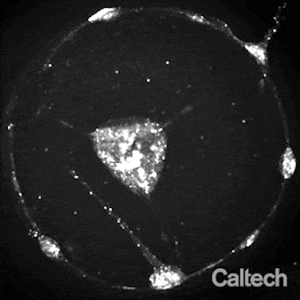
With a new genetic toolbox, researchers can view jellyfish neurons as they light up in real time. Jellyfish do not have a centralized brain; rather, their brain cells (neurons) are distributed in a diffuse net throughout the body. As shown in this video, this study discovered that there is actually spatial organization to the way that neurons are activated when the animal is coordinating behavior. Credit: B. Weissbourd
Caltech researchers have now developed a kind of genetic toolbox tailored for tinkering with Clytia hemisphaerica, a type of jellyfish about 1 centimeter in diameter when fully grown. Using this toolkit, the tiny creatures have been genetically modified so that their neurons individually glow with fluorescent light when activated. Because a jellyfish is transparent, researchers can then watch the glow of the animal’s neural activity as it behaves naturally. In other words, the team can read a jellyfish’s mind as it feeds, swims, evades predators, and more, in order to understand how the animal’s relatively simple brain coordinates its behaviors.
A paper describing the new study appears in the journal Cell on November 24, 2021. The research was conducted primarily in the laboratory of David J. Anderson, Seymour Benzer Professor of Biology, Tianqiao and Chrissy Chen Institute for Neuroscience Leadership Chair, Howard Hughes Medical Institute Investigator, and director of the Tianqiao and Chrissy Chen Institute for Neuroscience.
When it comes to model organisms used in laboratories, jellyfish are an extreme outlier. Worms, flies, fish, and mice—some of the most commonly used laboratory model organisms—are all more closely related, genetically speaking, to one another than any are to a jellyfish. In fact, worms are evolutionarily closer to humans than they are to jellyfish.
“Jellyfish are an important point of comparison because they’re so distantly related,” says Brady Weissbourd, postdoctoral scholar and first author on the study. “They let us ask questions like, are there principles of neuroscience shared across all nervous systems? Or, what might the first nervous systems have looked like? By exploring nature more broadly, we may also discover useful biological innovations. Importantly, many jellyfish are small and transparent, which makes them exciting platforms for systems neuroscience. That is because there are amazing new tools for imaging and manipulating neural activity using light, and you can put an entire living jellyfish under a microscope and have access to the whole nervous system at once.”
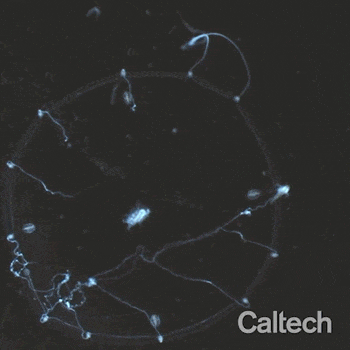
A jellyfish folds the right side of its body to bring a tiny brine shrimp to its mouth. Credit: B. Weissbourd
Rather than being centralized in one part of the body like our own brains, the jellyfish brain is diffused across the animal’s entire body like a net. The various body parts of a jellyfish can operate seemingly autonomously, without centralized control; for example, a jellyfish mouth removed surgically can carry on “eating” even without the rest of the animal’s body.
This decentralized body plan seems to be a highly successful evolutionary strategy, as jellyfish have persisted throughout the animal kingdom for hundreds of millions of years. But how does the decentralized jellyfish nervous system coordinate and orchestrate behaviors?
After developing the genetic tools to work with Clytia, the researchers first examined the neural circuits underlying the animal’s feeding behaviors. When Clytia snags a brine shrimp in a tentacle, it folds its body in order to bring the tentacle to its mouth and bends its mouth toward the tentacle simultaneously. The team aimed to answer: How does the jellyfish brain, apparently unstructured and radially symmetric, coordinate this directional folding of the jellyfish body?
By examining the glowing chain reactions occurring in the animals’ neurons as they ate, the team determined that a subnetwork of neurons that produces a particular neuropeptide (a molecule produced by neurons) is responsible for the spatially localized inward folding of the body. Additionally, though the network of jellyfish neurons originally seemed diffuse and unstructured, the researchers found a surprising degree of organization that only became visible with their fluorescent system.
“Our experiments revealed that the seemingly diffuse network of neurons that underlies the circular jellyfish umbrella is actually subdivided into patches of active neurons, organized in wedges like slices of a pizza,” explains Anderson. “When a jellyfish snags a brine shrimp with a tentacle, the neurons in the ‘pizza slice’ nearest to that tentacle would first activate, which in turn caused that part of the umbrella to fold inward, bringing the shrimp to the mouth. Importantly, this level of neural organization is completely invisible if you look at the anatomy of a jellyfish, even with a microscope. You have to be able to visualize the active neurons in order to see it—which is what we can do with our new system.”
Weissbourd emphasizes that this is only scratching the surface of understanding the full repertoire of jellyfish behaviors. “In future work, we’d like to use this jellyfish as a tractable platform to understand precisely how behavior is generated by whole neural systems,” he says. “In the context of food passing, understanding how the tentacles, umbrella, and mouth all coordinate with each other lets us get at more general problems of the function of modularity within nervous systems and how such modules coordinate with each other. The ultimate goal is not only to understand the jellyfish nervous system but to use it as a springboard to understand more complex systems in the future.”
The new model system is straightforward for researchers anywhere to use. Jellyfish lineages can be maintained in artificial sea water in a lab environment and shipped to collaborators who are interested in answering questions using the little animals.
Reference: “A genetically tractable jellyfish model for systems and evolutionary neuroscience” by Brandon Weissbourd, Tsuyoshi Momose, Aditya Nair, Ann Kennedy, Bridgett Hunt and David J. Anderson, 24 November 2021, Cell.
DOI: 10.1016/j.cell.2021.10.021
In addition to Weissbourd and Anderson, additional co-authors are Tsuyoshi Momose of Sorbonne Université in France, graduate student Aditya Nair, former postdoctoral scholar Ann Kennedy (now an assistant professor at Northwestern University), and former research technician Bridgett Hunt. Funding was provided by the Caltech Center for Evolutionary Science, the Whitman Center of the Marine Biological Laboratory, the Life Sciences Research Foundation, and the Howard Hughes Medical Institute.

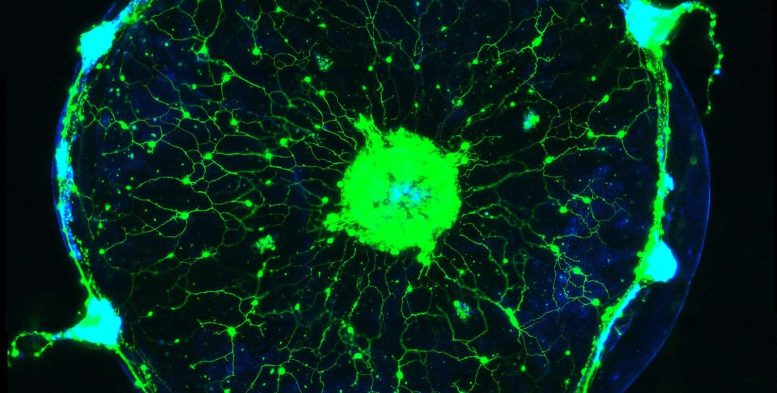
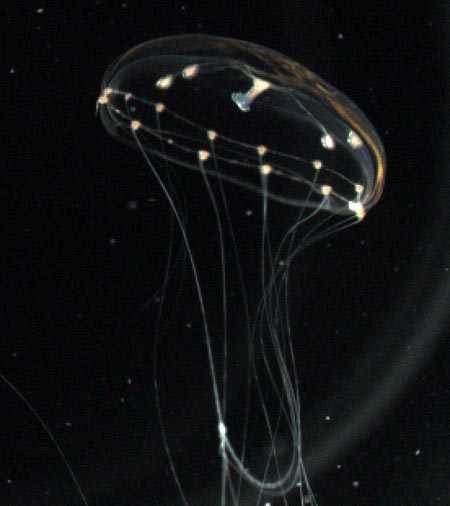
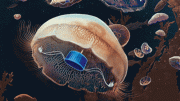
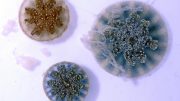
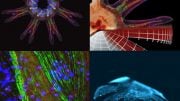
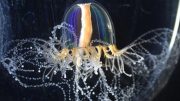


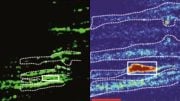
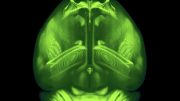
I’m waiting for them to create a Peanut Butter and Jellyfish. Yum.
With the pizza slices and the shrimp, there really is a whole buffet down there
JELLYFISH WILL SOMEDAY BE MASTERS OF THE UNIVERSE!!! they are quietly planning the take over sometime during the next couple of centuries…..mankind was prettymuch doomed to self destruct per design anyway…..
Babu G. Ranganathan*
(B.A. Bible/Biology)
OUR LIVING WORLD: NOT INVENTED BY NATURE
JUST BECAUSE something exists in nature does not mean it was invented by nature. If all the chemicals (i.e. amino acids, nucleic acids, etc.) necessary to make a cell were left to themselves, “Mother Nature” would have no ability to organize them into a cell. It requires an already existing cell to bring about another cell. The cell exists and reproduces in nature but nature didn’t invent or design it! Nature didn’t originate the cell or any form of life. An intelligent power outside of nature had to be responsible.
Miller, in his famous experiment in 1953, showed that amino acids (the building blocks of life) could form by chance. But, it’s not enough just to have amino acids. The various amino acids that make-up life must link together in a precise sequence, just like the letters in a sentence, to form functioning protein molecules. It has never been shown that various amino acids can bind together into a sequence by chance to form protein molecules.
Natural laws may explain how an airplane or cell works, but it’s not rational to believe that undirected natural laws can bring about an airplane or a cell.
ONCE YOU HAVE a complete and living cell then the genetic program (or code) and biological machinery exist to direct the formation of more cells, but how could the cell have originated naturally when no directing code and mechanisms existed in nature?
Mathematicians have said any event in the universe with odds of 10 to 50th power or greater is impossible! The probability of just an average size protein molecule arising by chance is 10 to the 65th power. Even the simplest cell is made up of many millions of various protein molecules along with and DNA/RNA..
The late great British scientist Sir Frederick Hoyle calculated that the odds of even the simplest cell coming into existence by chance is 10 to the 40,000th power! How large is this? Consider that the total number of atoms in our universe is 10 to the 82nd power.
The cell didn’t evolve. A partially evolved cell would quickly disintegrate, not wait millions of years to become complete and living.
WHAT ABOUT EVOLUTION? Only evolution within “kinds” is genetically possible (i.e. varieties of dogs, cats, horses, cows, etc.), but not evolution across “kinds” (i.e. from sea sponge to human). How could species have survived if their vital tissues, organs, reproductive systems were still evolving? Survival of the fittest would actually have prevented such evolution! Only limited evolution, variations of already existing genes and traits, is possible. Nature is mindless and has no ability to design and program entirely new genes for entirely new traits.
WHAT ABOUT NEW SPECIES: Although new species have come into existence, they don’t carry any new genes. They’ve become new species only because they can’t be crossed back with the original parent stock for various biological reasons. A biological “kind” allows for new species but not new genes. Nature has no ability to invent new genes for new traits. Only limited variations and adaptations are possible in nature, and all strictly within a biological “kind” (i.e. varieties of dogs, cats, etc.).
All species of plants and animals in the fossil record are found complete, fully formed, and fully functional. This is powerful evidence that all species came into existence as complete and fully formed from the beginning. This is only possible by creation.
What about natural selection? Natural selection doesn’t produce biological traits or variations. It can only “select” from biological variations that are possible and which have survival value. That’s why it’s called natural “selection.” The real issue is what biological variations are possible, not natural selection. Only variations and mutations of already existing genes or traits are possible.
Dr. Randy J. Guliuzza’s extensive research points to a better explanation than natural selection for variation and adaptation in nature. Dr. Guliuzza explains that species have pre-engineered mechanisms that enable organisms to continuously track and respond to environmental changes with system elements that correspond to human-designed tracking systems. This model is called CET (continuous environmental tracking). His research strongly indicates that living things have been pre-engineered to produce the right adaptations and changes required to live in changing environments. It’s much like a car that’s been pre-engineered so that the head lights turn on automatically when day changes to night.
Modern evolutionists believe and hope that over, supposedly, millions of years, random mutations in the genetic code caused by environmental radiation will generate entirely new genes for natural selection to use. This is total blind and irrational faith on the part of evolutionists. It’s much like believing that randomly changing the sequence of letters in a romance novel, over millions of years, will turn it into a book on astronomy! That’s the kind of blind faith macro-evolutionists have.
Mutations are accidents in the genetic, are mostly harmful, and have no capability of producing greater complexity in the code. Even if a good accident occurred, for every good one there would be hundreds of harmful ones with the net result, over time, being harmful, even lethal, to the species. Even if a single mutation is not immediately harmful, the accumulation of mutations over time will be harmful. At best, mutations only produce further variations within a natural species. Most biological variations are not due to mutations but from new combinations of already existing genes.
What about genetic and biological similarities between species? Genetic information, like other forms of information, cannot happen by chance, so it is more logical to believe that genetic and biological similarities between all forms of life are due to a common Designer who designed similar functions for similar purposes. It doesn’t mean all forms of life are biologically related! Only genetic similarities within a natural species proves relationship because it’s only within a natural species that members can interbreed and reproduce.
The actual similarity between ape and human DNA is between 70-87% not 99.8% as commonly believed. The original research stating 99.8% similarity was based on ignoring contradicting evidence. Only a certain segment of DNA between apes and humans was compared, not the entire DNA genome.
All the fossils that have been used to support human evolution have been found to be either hoaxes, non-human, or human, but not non-human and human (i.e. Neanderthal Man was discovered later to be fully human).
There has never been unanimous agreement among evolutionary scientists on ANY fossil evidence that has been used to support human evolution over the Many years, Including LUCY.
Also, so-called “Junk DNA” isn’t junk. Although these “non-coding” segments of DNA don’t code for proteins, they have recently been found to be vital in regulating gene expression (i.e. when, where, and how genes are expressed, so they’re not “junk”).
Read the author’s Internet article, NO MEAT-EATING ANIMALS EXISTED IN THE BEGINNING
Visit my latest Internet site: THE SCIENCE SUPPORTING CREATION (This site answers many arguments, both old and new, that have been used by evolutionists to support their theory)
Author of popular Internet article, TRADITIONAL DOCTRINE OF HELL EVOLVED FROM GREEK ROOTS
* I have had the privilege of being recognized in the 24th edition of Marquis “Who’s Who In The East” for my writings on religion and science, and I have given successful lectures (with question and answer time afterwards) defending creation from science before evolutionist science faculty and students at various colleges and universities.
Research has finally unraveled that such complex and precise systems can never evolve automatically and accidentally. There is a sagacious and all-dominant power named Allah/Eeshwar/God that purposefully creates whatever he desires.